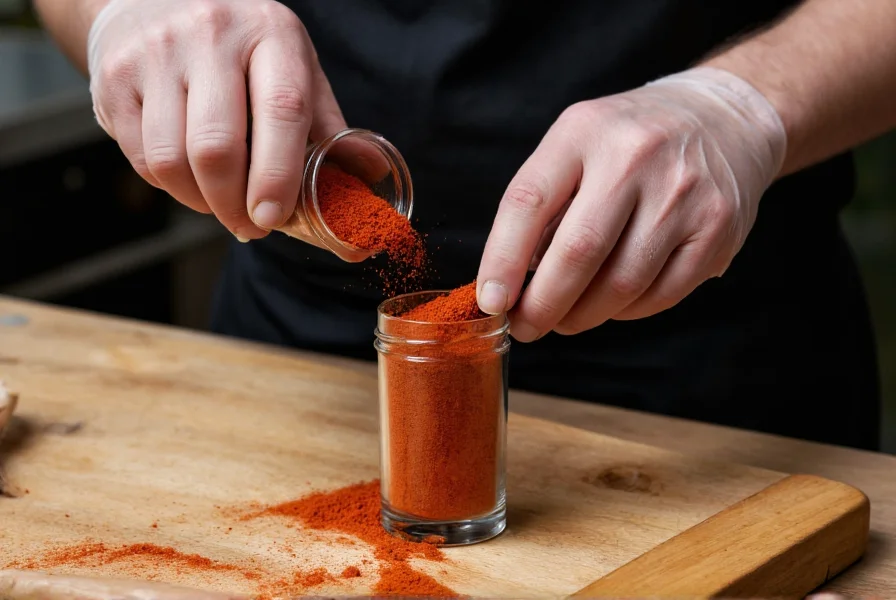When exploring easy cayenne pepper recipes for beginners, understanding this vibrant spice's characteristics is essential. Cayenne pepper, derived from dried and ground chili peppers, delivers a clean, sharp heat measuring 30,000-50,000 Scoville units. Unlike complex chili powders, pure cayenne offers straightforward heat without additional seasoning, making it perfect for precise flavor control in healthy recipes with cayenne pepper.
Understanding Cayenne Pepper's Culinary Role
Cayenne isn't just about heat—it enhances flavor perception and can balance rich or fatty ingredients. Professional chefs appreciate its ability to elevate dishes without overpowering other components when used judiciously. The capsaicin in cayenne also offers metabolic benefits, making it popular in spicy cayenne pepper dishes designed for both flavor and wellness.
Mastering Cayenne Measurements
One of the most common challenges with how much cayenne pepper to use in cooking involves understanding its potency. Unlike pre-mixed chili powders, pure cayenne requires careful measurement:
| Dish Type | Starting Amount | Adjustment Tip |
|---|---|---|
| Soups & Stews (4 servings) | 1/8 teaspoon | Add gradually during last 10 minutes of cooking |
| Marinades & Rubs | 1/4 teaspoon | Mix with oil to distribute heat evenly |
| Baked Goods | 1/16 teaspoon | Combine with dry ingredients first |
| Smoothies & Drinks | Pinch (1/32 tsp) | Start with less—you can always add more |
Top Recipe Categories Featuring Cayenne Pepper
Breakfast Boosters
Adding cayenne to morning meals provides gentle metabolic stimulation. Try cayenne pepper breakfast recipes like:
- Spiced Avocado Toast: Mash avocado with lime juice, salt, and a pinch of cayenne. Top with microgreens.
- Cayenne-Infused Smoothie: Blend frozen berries, banana, spinach, almond milk, and a tiny pinch of cayenne for surprising depth.
- Southwest Egg Scramble: Add 1/8 teaspoon cayenne to eggs with black beans and corn before scrambling.

Cajun & Creole Classics
For authentic best recipes using cayenne pepper in Southern cooking, cayenne forms the heat foundation in:
- Shrimp Etouffee: Build flavor with the "holy trinity" (onions, celery, bell peppers), then add 1/2 teaspoon cayenne to the roux.
- Cajun Roasted Vegetables: Toss vegetables with 1/4 teaspoon cayenne, garlic powder, and olive oil before roasting.
- Creole Shrimp Boil: Add 1 teaspoon cayenne to the boiling water along with traditional seasonings.
Unexpected Sweet Applications
Surprisingly, cayenne complements chocolate and fruit in mild cayenne pepper recipes:
- Dark Chocolate Truffles: Add 1/16 teaspoon cayenne to melted chocolate for sophisticated depth.
- Mango Salsa: Balance sweet mango with 1/8 teaspoon cayenne, red onion, and cilantro.
- Spiced Hot Chocolate: Stir 1/16 teaspoon cayenne into hot chocolate along with cinnamon.
Smart Substitutions and Storage
When you need cayenne pepper substitution in recipes, consider these options:
- For milder heat: Use paprika (triple the amount) or red pepper flakes (half the amount)
- For similar heat: Use hot sauce (1/4 teaspoon replaces 1/8 teaspoon cayenne)
- For complex flavor: Use chipotle powder (same amount, but adds smokiness)
Store cayenne pepper in an airtight container away from light and heat. Properly stored, it maintains potency for 1-2 years. Test older cayenne by smelling—it should have a sharp, distinctive aroma. Weak scent indicates diminished potency requiring slightly increased measurements.
Safety and Handling Tips
When working with cayenne pepper, protect your skin and eyes. Wear gloves when handling large quantities, and avoid touching your face. If you experience burning, dairy products like milk or yogurt neutralize capsaicin better than water. Always add cayenne gradually—you can't remove excess heat once incorporated.

Conclusion: Elevating Everyday Cooking
Incorporating cayenne pepper into your cooking repertoire transforms ordinary dishes into extraordinary experiences. Whether you're creating healthy recipes with cayenne pepper for metabolic benefits or simply seeking to enhance flavor complexity, this versatile spice deserves a permanent place in your pantry. Start with small amounts in familiar dishes, then experiment with bolder applications as your palate adjusts to its distinctive heat.











 浙公网安备
33010002000092号
浙公网安备
33010002000092号 浙B2-20120091-4
浙B2-20120091-4